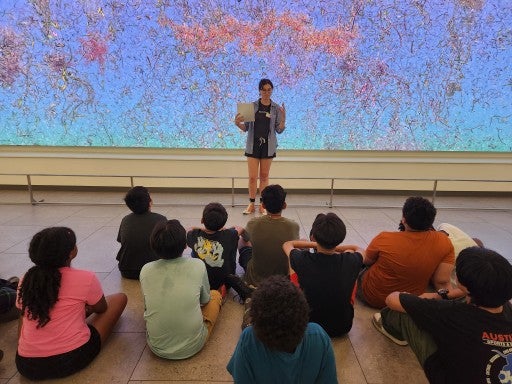
This summer, as Landmarks’ education intern, I helped design and lead several workshops for students attending the UT Prep Summer Camp, organized by UTeach Outreach. Over the course of four weeks, Landmarks’ Education Coordinator Catherine Whited and I met with more than 100 students, leading activities at Deborah Butterfield’s Vermillion, Sol LeWitt’s Wall Drawing #520, Jennifer Steinkamp’s EON, and Nancy Rubins’ Drawing. Specifically, I created activities responding to EON and Drawing. At each workshop, we explored concepts such as abstraction, authorship, technology, and transformation, connecting them to various STEM practices and fields.
EON is perhaps my favorite work in Landmarks’ collection, so I was very excited to build an activity around it. The work was created by Steinkamp using coding algorithms, so I wanted to host a coding activity without computers. I tasked students with creating 6x6 multi-colored pixel designs which they “coded” using grids on printed paper and colored pencils. After creating a gridded design, students coded their image in binary patterns, trading their instructions with a partner who then tried to execute the design without seeing the original. The exercise challenged a few of the students’ interpretations of coding because it removed it from a digital world and added an artistic component. That challenge, however, is part of what made the activity complimentary to the student’s STEM curriculum at the camp. All in all, we had a great discussion about coding and other forms of communication, synthesized in both the arts and STEM.
At Rubins’ Drawing we explored spectroscopy and light science. I tasked students with making their own spectroscopes–tools that separate light into color spectra– using only toilet paper tubes, construction paper, and CDs. With its metallic luster and jagged form, Rubins’ Drawing appears to be a sculpture, though it is actually made of thickly applied graphite on rag paper. The artist achieved this effect through manipulating the medium and utilizing light sciences. Similarly, our activity explored how light interacts with different objects. Some students gasped at the little rainbow that appeared inside their spectroscope and many noticed a changing intensity of yellow in their spectra when looking at the sky. As the activity continued, a few students created a periscope by removing the construction paper end caps of their spectroscopes and leaving an open hole above the angled CD. Whether they left with a spectroscope or a periscope, the students were excited to use their new tools.
Over the course of the four-week camp, I had a great time designing, preparing, and assisting Catherine Whited in leading the workshops. The students were very intuitive and creative, and it was interesting to see their application of STEM principles to artistic problems. The students were quick to question and critique the activities we planned and even when they didn’t follow the activity directions, they still learned about alternative processes. Our art class provided them a space to break rules they aren’t allowed to in their other STEM curriculum.
